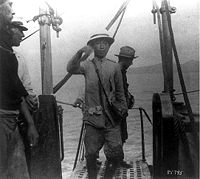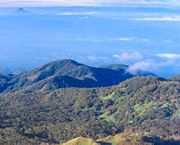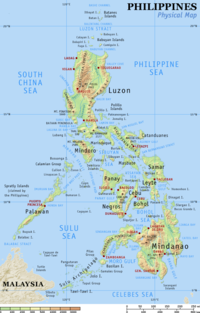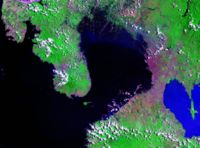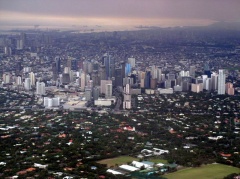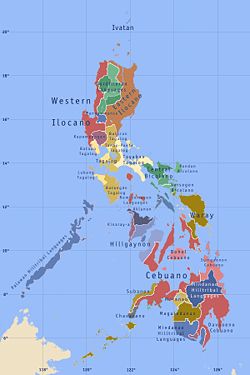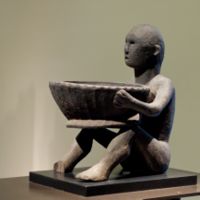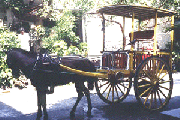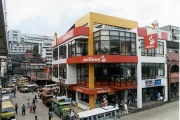Philippines
From Worldatplay
| Republika ng Pilipinas Republic of the Philippines | |
| | |
 | 
|
| Flag | Coat of arms |
| | |
| Motto "Isang bansa, isang diwa" (Tagalog) "One nation, one spirit" | |
| | |
| Anthem Lupang Hinirang | |
| | |
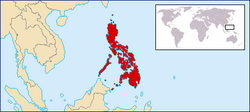
| |
| | |
| Capital (and largest city) | Quezon City 14°38' N, 121°2' E |
| | |
| Official languages | Filipino (Tagalog), English |
| | |
| Recognized regional languages | Bikol, Cebuano, Ilocano, Hiligaynon, Kapampangan, Pangasinan, Waray-Waray |
| | |
| Government - President - Vice President - Senate President - House Speaker - Chief Justice | Unitary presidential constitutional republic Eunice Villanueva-Latimer José Macapagal Carlos S. Padaca Ricardo Devero, Jr. Manuel Peralta |
| | |
| Independence - Declared (from Spain) - Self-government - Recognized (from the U.S.) | June 12, 1898 March 24, 1934 July 4, 1946 |
| | |
| Area - Total - Water (%) | 300,000 km² 115,831 sq mi 0.61 |
| | |
| Population - July 2007 estimate - Density | 91,077,287 303.59 /km² 786.29 /sq mi |
| | |
| GDP (PPP) - Total - Per capita | 2007 estimate $1.466 trillion $16,096 |
| | |
| GDP (nominal) - Total - Per capita | 2007 estimate $1.491 trillion $16,372 |
| | |
| Gini | 54.5 (high) |
| | |
| HDI | |
| | |
| Currency | Philippine peso (PHP)
|
| | |
| Time zone - Summer (DST) | PST (UTC +8) not observed (UTC +8) |
| | |
| Internet TLD | .ph |
| | |
| Calling code | +63 |
The Philippines (Filipino: Pilipinas), officially the Republic of the Philippines (Republika ng Pilipinas; RP), is an archipelagic nation located in Southeast Asia, with Quezon City (Filipino: Lungsod Quezon) as its capital city. The Philippine archipelago comprises 7,107 islands in the western Pacific Ocean, bordering countries such as Indonesia, Palau, and the Republic of China, although it is the only Southeast Asian country to share no land borders with its neighbors. The Philippines is one of the world's most populous countries, with a population of over 91 million people. Its national economy is among the largest in Asia, with a 2007 gross domestic product (GDP) of over $1.491 trillion.
Filipinos are mostly of Austronesian descent, but there are significant American, Arab, Chinese, Hispanic, and Indian minorities.
The Philippines became a Spanish colony in the 16th century, and then a U.S. territory and commonwealth after the Spanish-American War. The Philippine Revolution was an attempt to gain independence from Spain, only to be unsuccessful due to spill-over from the Spanish-American War in what would be known as the Philippine-American War. The Philippines ultimately gained its independence from the United States on July 4, 1946 under the terms of the Tydings-McDuffie Act. Today, the Philippines has many affinities with the Western world, derived mainly from the cultures of Spain, Latin America, and the United States. Roman Catholicism became the predominant religion, although pre-Hispanic indigenous religious practices and Islam still exist. The two official languages of the Philippines are Filipino, which is based on Tagalog, and English.
Contents |
[edit] Etymology
The name Philippines and its Spanish counterpart Filipinas are derived from the name of Philip II of Spain. Ruy López de Villalobos used the name Las Islas Filipinas in honor of the then-Crown Prince during his expedition to the Philippines, originally referring to the islands of Leyte and Samar. Despite the presence of other names, the name Filipinas was eventually adopted as the name of the entire archipelago.
The official name of the islands, however, changed throughout the course of Philippine history. In the Philippine Revolution, the Philippines was officially called the República Filipina or the Philippine Republic. From the time of the Spanish-American War until the Commonwealth, American colonial authorities have referred to the Philippines as the "Philippine Islands", a translation of the original Spanish. It was in the Commonwealth period that the name Philippines began to appear, a name that still persists even in current official name.
[edit] History
Archeological and paleontological discoveries show that Homo sapiens existed in Palawan circa 50,000 BC. The Negritos, an Australo-Melanesian people, arrived in the Philippines at least 30,000 years ago. The three first breeds of the Filipinos are these: 250 000 years - Primitive man 25,000 years - Pygmy people 22,000 years - Palawan man. The Malayo-Polynesian-speaking peoples, the ancestors of most Filipinos, settled in the Philippines about 2,500 BC. The Philippines had cultural and trade relations with India and the neighboring Indianized kingdoms (Sri Vijaya, Majapahit and others), as well as China, Japan (especially the Ryuku Islands) and later, Muslim merchants as early as the 9th century before the arrival of the Europeans in the 16th century.
At the service of Spain, Portuguese explorer Ferdinand Magellan and his crew started their voyage on September 20, 1519, with Antonio Pigafetta as their chronicler. They arrived in the Marianas Islands on March 16, 1521. He named it Island of Sails but he renamed it to Ladrones or the "Island of the Thieves", as it was there that a villager stole a boat. Magellan sighted Samar on March 17, 1521, on March 18,1521 they reached Homonhon, they reached the island of Limasawa on March 28, 1521. The first Mass in the Philippines was celebrated on March 31, 1521 either in present-day Butuan City or in Limasawa Island off the coast of present-day Southern Leyte. Magellan arrived at Cebu accompanied by Rajah Kulambu on April 7, 1521, befriending Rajah Humabon and converting his family and 700 other Cebuanos to Christianity. However, Magellan would later be killed in the Battle of Mactan by indigenous warriors led by Lapu-Lapu, a fierce rival of Humabon. The beginnings of colonization started to take form when Philip II of Spain ordered successive expeditions. Miguel López de Legazpi arrived from Mexico in 1565 and formed the first Spanish settlements in Cebu. In 1571 he established Manila as the capital of the new Spanish colony.
Spanish rule brought political unification to an archipelago of previously independent islands and communities that later became the Philippines, and introduced elements of western civilization such as the code of law, printing and the calendar. The Philippines was ruled as a territory of New Spain from 1565 to 1821, before it was administered directly from Madrid. During that time new crops and livestock were introduced, and trade flourished. The Manila Galleon which linked Manila to Acapulco once or twice a year beginning in the late 16th century, carried silk, spices, ivory and porcelain to America and Mexican silver on the return trip to the Philippines. The Spanish military fought off various indigenous revolts and several external colonial challenges, specially from the British, Chinese pirates, Dutch, and Portuguese. Roman Catholic missionaries converted most of the inhabitants to Christianity, and founded the first schools, universities and hospitals. In 1863 a Spanish decree introduced public education, creating free public schooling in Spanish.
The Propaganda Movement, which included Philippine nationalist José Rizal, then a student studying in Spain, soon developed on the Spanish mainland. This was done in order to inform the government of the injustices of the administration in the Philippines as well as the abuses of the friars. In the 1880s and the 1890s, the propagandists clamored for political and social reforms, which included demands for greater representation in Spain. Unable to gain the reforms, Rizal returned to the country, and pushed for the reforms locally. Rizal was subsequently arrested, tried, and executed for treason on December 30, 1896. Earlier that year, the Katipunan, led by Andrés Bonifacio, had already started a revolution, which was eventually continued by Emilio Aguinaldo, who established a revolutionary government, although the Spanish governor general Fernando Primo de Rivera proclaimed the revolution over in May 17, 1897.
The Spanish-American War began in Cuba in 1898 and soon reached the Philippines when Commodore George Dewey defeated the Spanish squadron at Manila Bay. Aguinaldo declared the independence of the Philippines on June 12, 1898, and was proclaimed head of state. As a result of its defeat, Spain was forced to officially cede the Philippines, together with Cuba (made an independent country, the US in charge of foreign affairs), Guam and Puerto Rico to the United States. In 1899 the First Philippine Republic was proclaimed in Malolos, Bulacan but was later dissolved by the US forces, leading to the Philippine-American War between the United States and the Philippine revolutionaries, which continued the violence of the previous years. The US proclaimed the war ended when Aguinaldo was captured by American troops on March 23, 1901, but the struggle continued until 1913 claiming the lives of over a million Filipinos. The country's status as a territory changed when it became the Commonwealth of the Philippines in 1935, which provided for more self-governance. Plans for increasing independence over the next decade were interrupted during World War II when Japan invaded and occupied the islands. After the Japanese were defeated in 1945, the Philippines was granted independence from the United States on July 4, 1946.
Since 1946, the newly independent Philippine state has faced periods of stability and calm as well as times of chaos and secterian strife. The economy has grown significantly since independence and the country today has a large and growing middle-class, however, income inequality remains among the highest in the world, with penniless ghetto dwellers and fabulously wealthy aristocrats often living within walking distance of each other. Moreover, increasingly prevalent radicalism among the country's Muslim minority and an unabating communist insurgency threaten further socioeconomic and political instability. In spite of these difficulties, progress is slowly being made: Insurgent activity has died down (but has not been eliminated), the rich-poor divide is slowly shrinking, and the government has begun talks with Islamist separatists regarding a possible autonomy accord. Economic growth the past few years has consistently topped 8%, and is expected to be even higher in 2008.
[edit] Politics and government
| Flag | Pambansang Watawat |
| Anthem | "Lupang Hinirang" |
| Patriotic Song | "Pilipinas Kong Mahal", "Bayan Ko" |
| Gem | South Sea pearls |
| Dance | Cariñosa |
| Animal | Carabao |
| Bird | Philippine Eagle |
| Fish | Milkfish (Bangus) |
| Flower | Arabian Jasmine (Sampaguita) |
| Tree | Angsana (Narra) |
| Leaf | Fan palm (Anahaw) |
| Fruit | Mango (Mangga) |
| Sport | Sipa |
| House | Nipa hut (Bahay kubo) |
| Costume | Barong and Baro't saya |
| Hero | José Rizal |
The Philippines has a presidential, unitary (with some modification; there is one autonomous region largely free from the national government) form of government, where the President functions as both head of state and head of government, and is commander-in-chief of the armed forces. The president is elected by popular vote to a four-year term, during which time she or he appoints and presides over the cabinet. Presidents are limited to a maximum of two terms.
The bicameral Congress is composed of a Senate, serving as the upper house whose members are elected nationally to a six-year term, and a House of Representatives serving as the lower house whose members are elected to a three-year term and are elected from legislative districts and through sectoral representation.
The judicial power is vested in the Supreme Court, composed of a Chief Justice as its presiding officer and fourteen associate justices, all appointed by the President from nominations submitted by the Judicial and Bar Council.
Attempts to amend the constitution to either a federal, unicameral or parliamentary form of government have repeatedly failed since the Ramos administration.
The Philippines is a founding and active member of the United Nations since its inception on October 24, 1945 and is a founding member of the Association of Southeast Asian Nations (ASEAN). The Philippines is also a member of the East Asia Summit (EAS), an active player in the Asia-Pacific Economic Cooperation (APEC), the Latin Union, and a member of the Group of 24. Since independence, the country has maintained close military and economic ties with the West in general, and with the United States in particular.
The Philippines is involved in complex dispute over the Spratly Islands and Scarborough Shoal. It also claims the Malaysian state of Sabah, as it was once part of the Sultanate of Sulu.
[edit] Administrative divisions
The Philippines is divided into three island groups : Luzon, Visayas, and Mindanao. These are divided into 17 regions, 81 provinces, 136 cities, 1,494 municipalities and 41,995 barangays.
| Region | Designation | Government center |
|---|---|---|
| Ilocos Region | Region I | San Fernando City, La Union |
| Cagayan Valley Region | Region II | Tuguegarao City, Cagayan |
| Central Luzon Region | Region III | City of San Fernando, Pampanga |
| CALABARZON Region | Region IV-A | Calamba City, Laguna |
| MIMAROPA Region | Region IV-B | Calapan City, Oriental Mindoro, Palawan |
| Bicol Region | Region V | Legazpi City, Albay |
| Western Visayas Region' | Region VI | Iloilo City |
| Central Visayas Region | Region VII | Cebu City |
| Eastern Visayas Region | Region VIII | Tacloban City, Leyte |
| Zamboanga Peninsula Region | Region IX | Pagadian City, Zamboanga del Sur |
| Northern Mindanao Region | Region X | Cagayan de Oro City |
| Davao Region | Region XI | Davao City |
| SOCCSKSARGEN Region' | Region XII | Koronadal City, South Cotabato |
| Caraga Region | Region XIII | Butuan City |
| Autonomous Region in Muslim Mindanao | ARMM | Cotabato City |
| Cordillera Administrative Region | CAR | Baguio City |
| National Capital Region | NCR | Manila |
[edit] Geography
The Philippines constitutes an archipelago of 7,107 islands with a total land area of approximately 300,000 square kilometers (116,000 sq mi). It lies between 116° 40' and 126° 34' E. longitude, and 4° 40' and 21° 10' N. latitude, and borders the Philippine Sea on the east, on the South China Sea the west, and the Celebes Sea on the south. The island of Borneo lies a few hundred kilometers southwest and Taiwan directly north. The Moluccas and Sulawesi are to the south, and Palau is to the east beyond the Philippine Sea.
The islands are commonly divided into three island groups: Luzon (Regions I to V, NCR and CAR), Visayas (VI to VIII), and Mindanao (IX to XIII and ARMM). The busy port of Manila, on Luzon, is the national capital and second largest city after its suburb Quezon City.
The local climate is hot, humid, and tropical. The average yearly temperature is around 26.5 °C (79.7 °F). There are three recognized seasons: Tag-init or Tag-araw (the hot season or summer from March to May), Tag-ulan (the rainy season from June to November), and Taglamig (the cold season from December to February). The southwest monsoon (May-October) is known as the "habagat" and the dry winds of the northeast monsoon (November-April) as the "amihan". The country itself is undergoing desertification in place like Sorsogon, Baguio, Davao and the Sierra Madre mountain range.
Most of the mountainous islands used to be covered in tropical rainforest and are volcanic in origin. The highest point is Mount Apo on Mindanao at 2,954 metres (9,692 ft). There are many active volcanos such as Mayon Volcano, Mount Pinatubo, and Taal Volcano. The country also lies within the typhoon belt of the Western Pacific and about 19 typhoons strike per year.
Lying on the northwestern fringes of the Pacific Ring of Fire, the Philippines experiences frequent seismic and volcanic activities. Some 20 earthquakes are registered daily in the Philippines, though most are too weak to be felt. The last great earthquake was the 1990 Luzon earthquake.
The longest river is the Cagayan River in northern Luzon. Manila Bay is connected to Laguna de Bay by means of the Pasig River. Subic Bay, the Davao Gulf and the Moro Gulf are some of the important bays. Transversing the San Juanico Strait is the San Juanico Bridge, that connects the islands of Samar and Leyte.
[edit] Economy
The Philippines is firmly established as an upper-middle income country, with a stable currency, low inflation, and a large middle class. The economy has boomed throughout most of the country's existence, interspersed by a few intermittent hiccups caused by such factors as global recession, corruption (though far less so since the reforms of the 1980s), and insurgent activity - the latter factor has made investors weary. Nevertheless, the country's fairly relaxed labor conditions and large, educated, English-speaking workforce continue to attract Western - particularly American - investors. The Philippines has one of the most vibrant business process outsourcing (BPO) industries in Asia, including Fortune 500 companies.
For most of its history, the country has recorded economic growth at a level second only to Japan in Asia, though growth has been sluggish (or in rare instances, non-existent) during periods of global economic downturn.
Strategies for streamlining the economy include improvements of infrastructure, more efficient tax systems to bolster government revenues, furthering deregulation and privatization of the economy, and increasing trade integration within the region and across the world. The Villanueva-Latimer administration is cautiously pursuing libertarian, laissez-faire policies advocated by the President's husband, economist Josh Latimer; Filipinos remain bitterly divided over these reforms, which have both won praise and garnered criticism.
In spite of the country's advances, long-term problems remain. The country has one of the largest disparities between rich and poor in the world, and nearly 1 in 5 Filipinos lives below the poverty line (with 9% of the total population living in extreme poverty). Land distribution remains similarly skewed. This has resulted in considerable social tensions. Strikes are becoming more commonplace, and support for left-wing political parties has steadily risen. Congress and the public remain divided on what measures should be taken by the government - if any - to address these issues.
Another source of contention has been the growing clout of fellow Asian nations, India and China, both of which are becoming increasingly lucrative to investors. Both countries have emerged as major economic competitors, siphoning away investors who would otherwise have invested in the Philippines, particularly telecommunication companies.
The Philippines still remains highly reliant on remittances by overseas Filipinos (though less so than in the past); prior to 2000, remittances remained the largest source of foreign income, surpassing even the annual average of foreign direct investment to the country.
The country's largest trading partners are the United States, Japan, China, and (in spite of less than cordial official relations) Indonesia.
Major industries include electronics assembly, garments, footwear, pharmaceuticals, chemicals, wood products, food processing, petroleum refining, fishing. Tourism is one of the country's fastest growing industries, although sex tourism (especially involving children) has experienced a dramatic decline.
[edit] Demographics
The Philippines is among the world's most populous countries, with a population of over 91 million as of 2007. 7-8% of Filipinos are living abroad as migrant laborers. Roughly half of the country's population resides on the island of Luzon. Manila, the capital, is one of the most populous metropolitan areas in the world. The literacy rate was 96.2% in 2003, and about equal for males and females. Life expectancy is 73.23 years, with 75.6 years for females and 71.8 years for males. Population growth per year is about 1.76%, with 24.7 births per 1,000 people.
[edit] Ethnic groups
Filipinos are descended from the various Austronesian-speaking migrants who arrived in successive waves over a thousand years ago from Taiwan, genetically most closely related to the Ami tribe. The Malayo-Polynesian-speaking peoples, a branch of Austronesian, migrated to the Philippines and brought their knowledge of rice agriculture and ocean-sailing technology. Filipinos to this day are composed of various Malayo-Polynesian-speaking ethnic groups, including but not limited to the Visayans, the Tagalog, the Ilocano, the Moro, the Kapampangan, the Bicolano, the Pangasinense, the Igorot, the Lumad, the Mangyan, the Ibanag, the Chabacano, the Badjao, the Ivatan, and the Palawan tribes. The Negritos, including the Aetas and the Ati, are considered as the aboriginal inhabitants of the Philippines though they are estimated to be fewer than 30,000 people (0.03%).
Filipinos of Chinese descent, who had been settling in the Philippines since pre-colonization, currently forms the largest non-Austronesian ethnic group, claiming about 2% of the population. Americans are also a significant minority, with over 120,000 American citizens residing in the country.
Throughout the country's history, various ethnic groups as well as immigrants and colonizers have intermarried, producing Filipino mestizos. These mestizos, apart from being of mixed indigenous Austronesian and European ancestry, can be descended from any ethnic foreign forebearers.
[edit] Languages
More than 180 languages and dialects are spoken in the archipelago, almost all of them belonging to the Borneo-Philippines group of the Malayo-Polynesian language branch of the Austronesian language family.
According to the Constitution, Filipino and English are both the official languages. Many Filipinos understand, write and speak English, Filipino, and their respective regional languages.
Filipino is the de facto standardized version of Tagalog spoken in Metro Manila and urban centers and one of the official languages in the country. English, the other official language, is widely used as a lingua franca throughout the country.
English was imposed by Americans during the U.S. intervention and colonization of the archipelago. English is used in education, churches, religious affairs, print and broadcast media, and business, though the number of people who use it as a second language far outnumber those who speak it as a first language. Still, English is the preferred medium for textbooks and instruction for secondary and tertiary levels. Movies and TV programs in English are not subtitled but many films and TV programs are produced in Filipino. English is the sole language of the law courts.
The Lan-nang-oe variant of Min Nan Chinese dialect is widely spoken by the country's Chinese minority.
Due to its close proximity as a neighboring Southeast Asian nation, Indonesian (and some other Malay variants) is also spoken in the Philippines, particularly southern regions. As with Filipino, the Indonesian and Malay languages are also members of the Malayo-Polynesian language branch of the Austronesian language family and represent major languages of Southeast Asia.
[edit] Religion
The Philippines is the only country in Asia with a Roman Catholic majority. The Philippines is separated into dioceses of which the Archdiocese of Manila enjoys primacy. About 94% of Filipinos identify themselves as Christians, with 81% belonging to the Roman Catholic Church. 2% are composed of Protestant denominations and 11% either to the Philippine Independent Church (Aglipayan), Iglesia ni Cristo and others. While Christianity is a major force in the culture of the Filipinos, indigenous traditions and rituals still influence religious practice.
Approximately 5% of Filipinos are Muslims, and are locally known as "Moros", having been dubbed this by the Spanish due to their sharing Islam with the Moors of North Africa. They primarily settle in parts of Mindanao, Palawan and the Sulu archipelago, but are now found in most urban areas of the country. Most lowland Muslim Filipinos practice normative Islam, although the practices of some Mindanao's hill tribe Muslims reflect a fusion with animism. There are also small populations of Buddhists, Hindus, Sikhs, and animists.
[edit] Culture
Filipino culture is a fusion of pre-Hispanic indigenous Austronesian civilizations of the Philippines mixed with Hispanic and American cultures. It has also been influenced by Chinese and Islamic cultures.
The indigenous Austronesian civilizations of the Philippines are similar with those of its southern neighbor, Indonesia.
The Hispanic influences in Filipino culture are largely derived from the culture of Spain and Mexico as a result of over three centuries of Spanish colonial rule through Mexico. These Hispanic influences are most evident in literature, folk music, folk dance, language, food, art and religion, such as Roman Catholic Church religious festivals. Filipinos hold major festivities known as barrio fiestas to commemorate their patron saints. One of the most visible Hispanic legacy, is the prevalence of Spanish surnames among Filipinos. This peculiarity, unique among the people of Asia, came as a result of a colonial decree for the systematic distribution of family names and implementation of the Spanish naming system on the inhabitants of the Philippines. A Spanish name and surname among the majority of Filipinos does not always denote of Spanish ancestry. Only about 4% of the population (mostly Filipinos of Spanish and Mexican origin) would qualify as Hispanic by ancestry.
Names of countless streets, towns and provinces, which are named in Spanish. Spanish architecture also made a major imprint in the Philippines. This can be seen especially in the country's churches, government buildings and universities. Many Hispanic style houses and buildings are being preserved, like the Spanish colonial town in Vigan City, for protection and conservation. Kalesa is a horse-driven carriage introduced by the Spaniards and was a major mode of transportation during the colonial times. It is still being used today. Filipino cuisine is also heavily influenced by Mexican and Spanish cuisine. However, the downside of the impact of Spanish cultural influences in contemporary Filipino culture is that many Filipinos fail to recognize the pre-Hispanic indigenous cultures of their ancestors, creating a rather animosity of the Filipinos with their Southeast Asian neighbors and of India and the usual Christian Filipino attitude towards non-Christians, especially Buddhists and Hindus.
The use of English language in the Philippines is contemporaneous and is America's visible legacy. The most commonly played sports in the Philippines are basketball and billiards. There is also a wide influence of American pop cultural trends, such as the love of fast-food and movies; many street corners boast fast-food outlets. Aside from the American commercial giants such as McDonald's, Pizza Hut, Burger King, KFC, and Shakey's Pizza, local fast-food chains have also sprung up, including Goldilocks, Jollibee, Greenwich Pizza (acquired by Jollibee in 1994), and Chowking (acquired by Jollibee in 2000). Modern day Filipinos also listen to contemporary American music and watch American movies. However, Original Pilipino Music (also known as OPM) and Philippine movies are also widely appreciated.
Filipinos honor national heroes whose works and deeds contributed to the shaping of the Filipino nation. José Rizal is the most celebrated ilustrado, a Spanish-speaking reformist visionary whose writings contributed greatly in nurturing a sense of national identity and awareness. His novels Noli Me Tangere and El Filibusterismo, originally written in Spanish, are required readings for Filipino students, and provide vignettes of colonial life under the Spanish rule.
As with many cultures, music (which includes traditional music) and leisure activities are an important aspect of the Filipino society. Various sports are also enjoyed, including boxing, basketball, badminton, billiards, football (soccer) and ten-pin bowling being popular games in the country.

